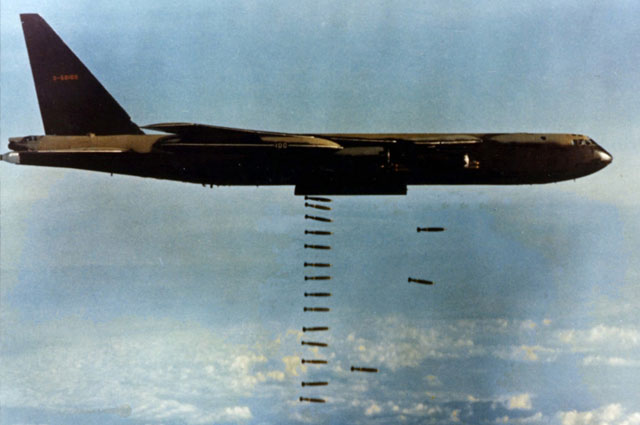Posted on February 11, 2013
By Ray Panko | [email protected] | Pearl Harbor Aviation Museum
Intercontinental Strategic and Tactical Bomber

B-52 dropping up to 81 1,000 pound bombs. Air Force Photograph 041105-O-9999G-012
Since the 1950s, the Boeing B-52 has been America’s “big stick.” This massive and far-ranging aircraft began as a high-level strategic nuclear bomber, changed to a low-level nuclear strategic bomber when Soviet anti-aircraft missiles improved, and then evolved again into a conventional bomber in Vietnam. Although the B-52 remains nuclear capable, its role since the 1960s has been to drop massive loads of conventional bombs. Although its official name is Stratofortress, nearly everybody calls it the BUFF—the Big Ugly Fat Fellow. Early models of the B-52 had a crew of five—two pilots, a bombardier, a route navigator, and electronic weapons systems officer, and a tail gunner. Today, in the B-52H, it flies without a tail gun or tail gunner.
The B-52 was born in October 1948. Boeing engineers traveled to Wright Field, Ohio, to pitch a new bomber to the Air Force. It had a rocky beginning. The original XB-52 design, chosen by the Army Air Forces in 1946, was for a straight-wing, six-engine, propeller-powered heavy bomber. On Oct. 21, 1948, Boeing Chief Engineer Ed Wells and his design team were in Dayton, Ohio, when the Air Force’s chief of bomber development told them to scrap the propellers and come up with an all-jet bomber. Over the following weekend, in a Dayton hotel room, the team designed a new eight-engine jet bomber, still called the B-52, made a scale model out of balsa wood and prepared a 33-page report. The Air Force was sold. The first flight of a B-52 Stratofortress (the YB-52 prototype) was publicly announced for Tuesday, April 15, 1952, which turned out to be an unusually warm and sunny Seattle day. Its two pilots sat behind each other, as in the B-47. Insisting that bomber pilots sit side by side, Curtis LeMay personally ordered that the two pilots be seated side by side.
The final result was an enormous aircraft weighing in at 488,000 pounds and was the B-52H. It had eight Pratt & Whitney TF33-P-3 turbofan engines, with 17,000 pounds of thrust apiece, a maximum speed of 650 mph, a ceiling in excess of 50,000 feet, and a range of 10,000 miles, globally with in-flight refueling. (In contrast, a World War II Boeing B-17 Flying Fortress weighed one tenth as much, could fly half as fast, could fly one fifth as far, and had one eighth the bomb load.)

Figure 1: B-17 and B-52. Air Force Photograph 060513-f-0558k-001
For many years, the B-52 was the center of the Strategic Air Command’s (SAC) arsenal. In fact, the B-52 outlived SAC. It originally flew at very high altitudes, above the reach of Soviet anti-aircraft fire. Later, as the Soviet Union developed high-altitude surface-to-air missiles, the B-52s were reengineered to penetrate Soviet territory at low level.
In Vietnam, the B-52 was again reengineered—this time to drop conventional bombs. In 1965, modification of B-52D aircraft began to increase their conventional bomb load. The “Big Belly” modifications resulted in the ability to carry 108 conventional bombs both internally and externally. This means that one aircraft could carry 54,000 pounds of bombs, roughly the equivalent of ten (10) World War II B-17s. These B-52s pounded North Vietnamese targets, but they mostly dropped massive bomb loads on suspected enemy positions in South Vietnam. During the war, there were 126,615 Arc Light saturation-bombing sorties from June 1965 until August 1972. Each Arc Light plane could carry up to 60,000 pounds of bombs. Missions were commonly flown in three-plane formations known as “cells” and were also employed when ground units in heavy combat requested fire support.

Figure 2: B-52 drops live retarded ordinance. Air Force Photograph 040518-F-0000D-004
In Desert Storm, the BUFFs repeatedly proved their worth. Two versions of the B-52 were flown during Desert Storm; the earlier Pratt & Whitney J57 powered B-52G and the newest model, the B-52H. They flew over 1,600 sorties and dropped almost 13 million pounds of bombs. B-52s have also been used heavily in the more recent Iraq and Afghanistan wars. However, in newer wars, B-52s typically drop a single smart bomb at a time; on a single long mission, a B-52 may destroy numerous individual targets.

Figure 3: B-52 drops a Single JDAM. Air Force Photograph 030408-F-0000C-002
The B-52H made its first flight March 6, 1961, and is still in service. In all, 744 B-52s were produced by Boeing in their Seattle, WA, and Wichita, KS, plants between 1952 and 1962. Today, there are about 90 B-52s left, all of them H models. The Air Force expects to retain as many of these as it can for many years to come. B-52s will certainly be with us until 2020 and forecasted out to 2040. Although the B-1B and B-2 are newer and better aircraft, the Air Force only ordered limited numbers of each. To meet future requirements, B-52s will have to be maintained with great care. There have already been father-son pilots in families, and there will soon be father-son-granddaughter pilots.
Specifications: B-52H
| Type | Intercontinental Strategic and Conventional Bomber |
| Crew | 5 |
| Length | 161’ |
| Wingspan | 185’ |
| Height | 41’ |
| Wing area | 2,900 sq ft |
| Weight empty | 306,000 lb |
| Weight loaded | 488,000 lb |
| Speed maximum | 650 mph |
| Ceiling | 55,000’ |
| Engines | Eight TF-33-P-3 turbofans |
| Thrust per engine | 17,000 lb |
| Bomb load | 81 five hundred pound bombs (“Big Belly Ds”) or 20 cruise missiles externally and or 4 to 8 nuclear weapons internally |
Source: Winchester, 2006
References
Boeing. B-52 Stratofortress. http://www.boeing.com/history/boeing/b52.html.
Lee, David. Boeing: From Peashooter to Jumbo, Chartwell Books: Edison, New Jersey, 1999.
Winchester, Jim. (ed.) Military Aircraft of the Cold War, Thunder Bay Press: San Diego, CA, 2006.

